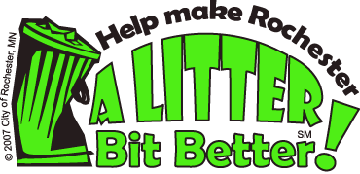Litter Facts
- Litter is waste that is out of place. It may be either man-made or natural materials. If outside a proper receptacle, items such as paper, plastic, glass, metal, building materials, discarded food, cigarette and cigar butts and rubber scraps are litter.
- Litter provides a breeding place for rodents, insects and disease.
- One cubic foot of garbage is capable of generating 75,000 flies.
- Trash thrown from motor vehicles can temporarily blind drivers, and may increase the number of crashes. Debris that falls from uncovered trucks is a constant threat to motorists.
- Researchers calculate that 55% of all littering is done intentionally by people who drop or discard products.
- Food and beverage packaging constitutes 51% of roadside litter.
- Litter is a threat to wildlife and plants. Small animals may crawl into bottles and cans and be unable to get out. Plastic six-pack holders attract birds and other animals that may become entangled in them. Littered objects may break delicate plant stalks and stems, and can eventually kill entire plants.
- Litter is expensive to pick up. Minnesota spends $5 million a year collecting litter – in addition to what cities and counties spend!
- Recycling is an alternative to littering.
Have a comment? Join us on Facebook!
